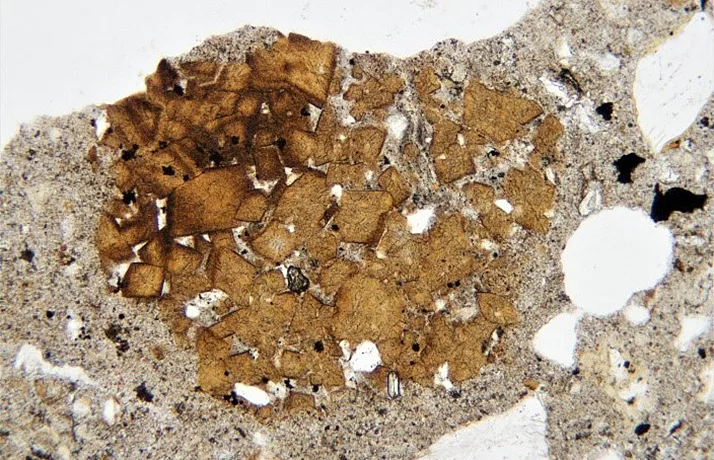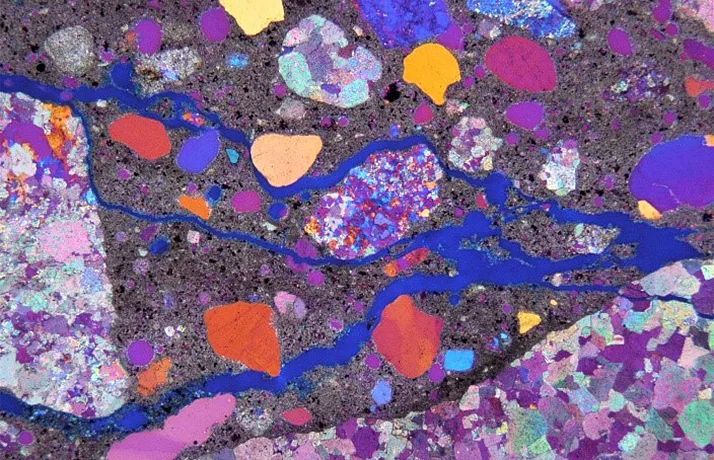
PRESERVING PIECES OF THE PAST: USING CONCRETE PETROGRAPHIC ANALYSIS TO HELP REVITALIZE + REPURPOSE OLD BUILDINGS
by Ron Sturm
Just a few blocks east of the Jensen Hughes Chicago Concrete Laboratory is the Fulton Market neighborhood, which has transitioned over the years from an industrial neighborhood to a neglected community. It is now becoming an urban renewal area with new construction and extensive renovation of existing buildings into restaurants, condos, and office spaces.
Such is the scene in many urban cities and communities throughout the United States. Given dwindling natural resources and a new urgency to conserve and repurpose, many old and historic structures are being repaired and renovated for new use, saving resources, money and pieces of the neighborhood’s past.
How Do We Know If Structures Are Safe For Repurposing?
When determining whether concrete and masonry structures can be revitalized for new use, one of the first steps is to have the site inspected and assessed by a qualified evaluation engineer. As part of that assessment, laboratory testing of the existing concrete or masonry material is usually deemed necessary to assess the structure's condition and evaluate existing construction materials for possible reuse.
Laboratory testing can assess the strength and continued durability of the material to assist engineers in the initial repair design. The original construction drawings and specifications may not be available, so field samples are obtained to perform a series of laboratory tests. Cores may be taken from existing concrete floors, walls and foundations. Or brick and mortar samples may be collected from masonry for physical and compositional characterization.
As part of the testing plan, petrographic examinations are often performed to provide additional materials analysis and insight into the composition of the original concrete, mortar, brick, or stone to assist in properly repairing and conserving original structures.
How Can Concrete Petrography Help Us Understand Old and Historic Structures?
What is petrography? Petrography is the microscopical analysis of construction materials. It can reveal a world that is not easily seen by the naked eye but very critical to understanding materials like concrete, masonry and stonework. Features of these materials seen under the microscope may appear as bizarre, abstract pieces of artwork as shown in the “micrographs” below. But to the trained eye of the petrographer, the ingredients used to make the original mortar or concrete are identified so appropriate and durable modern equivalents can be developed for repair.
Petrographic analysis provides information regarding the composition and condition of the investigated concrete, mortar, or other construction materials. Stone and aggregate used in these construction products are described in relation to their composition, physical properties and durability. The binder holding the aggregate together is thoroughly characterized, cementitious constituents are identified and deleterious mechanisms damaging the concrete are assessed.
Combined with other laboratory analyses and physical tests, petrographic testing can help characterize original materials (e.g., mortar, dimension stone, concrete), assist in formulating new repair products, and reveal original construction practices and issues. Developers, conservators, and construction companies would need this information to pursue renovation and occupancy of the structures and assure that any repair methods used are compatible with the original construction.
We provide expert knowledge on concrete and masonry structures using our petrographic analysis lab and testing capabilities. Our Concrete Laboratory has an experienced petrographer and the tools to perform the necessary tests and analyses to provide recommendations for repurposing old and historic buildings.

Thin section micrograph showing a relic grain of natural cement in mortar from a historic bridge in New England, ca, 1847. 200X magnification. Plane polarized light.

Thin section micrograph showing damage from cyclic freezing and thawing in outdoor exposed concrete. 40X magnification. Polarized light.












